Hawks Vs Owls – Characteristics, Roles, Rarity, And Power
Hawks and owls are two magnificent birds, and with their hunting skills, they secure the top places in the food web of birds. The funny thing is, except for the ranking, they are quite different.
Hawks have outstanding day vision and agility, while owls are the terror of the night with their unique night vision, strong talons, and silent flight. Also, hawks can hunt owls during the day, while owls can take revenge at night.
Now the question is, Hawks vs. owls – why do they differ from each other, and can one bird overthrow the other? I will help you discover the owls and hawks’ facts and understand the birds properly. So, let’s move forward.
Hawks Vs Owls – What Defines Them?
While talking about hawks vs. owls, your first thought is probably, what makes them distinct from each other? So, I reviewed the general characteristics, habits, and habitats of these birds.
| Defining Characteristics | Hawks | Owls |
| Size | Usually smaller, the largest one is around 60 cm. | Usually bigger, the largest one is around 70 cm. |
| Nature | Diurnal | Nocturnal |
| Speed of Flight | 120 mph (Maximum) | 40 mph (Maximum) |
| Dietary Habit | Carnivore | Carnivore |
| Geographic Distribution | The West Indies, Jamaica, and Central and around North America. | Except for Antarctica, they live everywhere in the world. |
| Habitat | Open places like grasslands, deserts, etc. | Evergreen forests, mountains, grasslands, and abandoned areas |
| Mating Nature | Monogamous | Monogamous except for 10 species of owls |
| Wingspan | 1 – 1.5 meters (Maximum) | 2-meter maximum |
| Physical distinctive feature | Sharp facial features, long tail. | A rounder facial feature and a short tail. |
Hawk Vs Owls – Explanation of the Key Differences
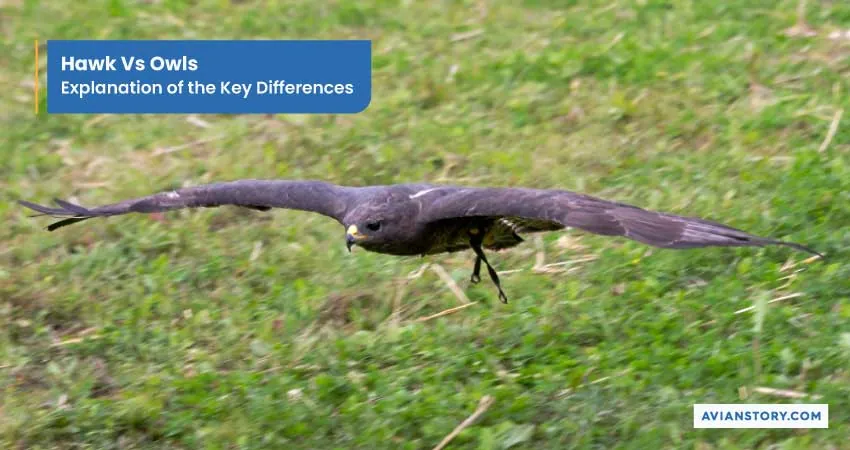
Though both of them are predator birds, they are members of different scientific families. Hawks are Accipitride as they are from the family of prey birds, Accipitridae. And as you know, Owls are nocturnal, so they come from the deadly nocturnal prey family, Strigiformes.
Nevertheless, if you want to know the two birds in and out, let’s continue to discover more of their traits.
Size and Weight
- Hawk: A total of 270 types of hawk species have been discovered by scientists till now. Tiny Hawk (Accipiter superciliosus) is the smallest, while Ferrugineus (Buteo Regalis) is the largest among them. A male Tiny Hawk can be 20 cm long with a weight of 74g, while a female one can be 26.5cm with a weight of 120g. You can find them in North America, including Nicaragua, Ecuador, Bolivia, Northern Argentina, Southern Brazil, etc. Thelargest hawk in the world, the Ferruginous of North America, can be 51- 71 cm long with a weight of 907g – 2.3 kg.
- Owl: The smallest one is the Elf Owl (Micrathene whitneyi), with a size of 12.5-14.5cm while weighing around 40g. Moreover, Blakiston’s fish owl (Ketupa blakiston) is the largest. You can find them in eastern Asia. A male Blakiston’s fish weighs around 2.95-3.6 kg, while a female weighs around 2.95- 4.6kg. Usually, they are around 60-72 cm long.
Appearance
Hawks and owls are quite different in looks; hawks have sharp facial features with smaller eyes, while owls have gentler, rounder facial features with bigger, rounder eyes.Besides, hawks have smaller faces proportionate to their whole body, whereas owls’ heads are bigger compared to their bodies.
You can tell them apart by their body color, too. Usually, hawks are of various shades of brown, while owls are a mix of fair and darker shades. Also, owls can move their heads in a 3/4th circle, but hawks can only turn their heads 180 degrees.
Activity: Diurnal vs. Nocturnal
- Hawk: Hawks are diurnal and active hunters during the daytime because of their excellent eyesight. You can see them landing on their prey with powerful flight. They are considered one of the best members of the diurnal birds of prey group.
- Owl: Contrarily, except for a few species, usually, owls are usually nocturnal and active at night as they have excellent hearing and a rare adaptability to low light.
Examples of crepuscular owl species are pygmy owls (Genus: Glaucidium), like the Eurasian pygmy owl (Glaucidium passerinum) on the list. On the other hand, the short-eared owl (Asio flammeus) and the burrowing owl (Speotyto cunicularia) are examples of diurnal species.
Hawks Vs. Owls- Which One Is More Powerful?
As you know, one is diurnal while the other is nocturnal, so they can’t face each other in their comfort time. However, both usually attack the other babies. Generally, at night, the hawk will fail to protect its babies as its vision is weak during the night. Also, compared to owls, the talons of hawks are weak.
Conversely, though an owl’s eye site is significantly weaker than a hawk’s during the day, its body and talons are way stronger. So, the probability of successfully defending the attack is very high.
How Do Hawks And Owls Communicate?
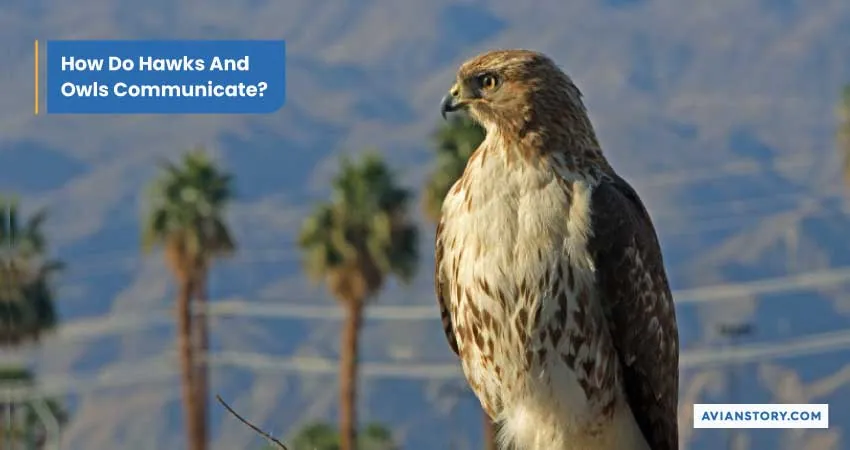
Both of these birds use voices, screams, and different body language to communicate with each other. Let’s have a closer look at the methods.
Vocalization
Hawks communicate, usually by screeching. However, the tone and loudness of it will change depending on the hidden message. Owls communicate primarily by hooting.
Aside from that, they communicate via chirping, whistling, grunting, and shrieking. Also, you may notice that different species have different calling sounds.
Body Language
Usually, hawks show aggressiveness by holding their heads high and puffing their feathers up. However, during courtship, they will appear with a smothering feather and do some acrobatics.
Owls also communicate with their bodies; a relaxed owl will look fluffy, and an alert one will look slim.
What Is the Role of Hawks and Owls in their Ecosystem?
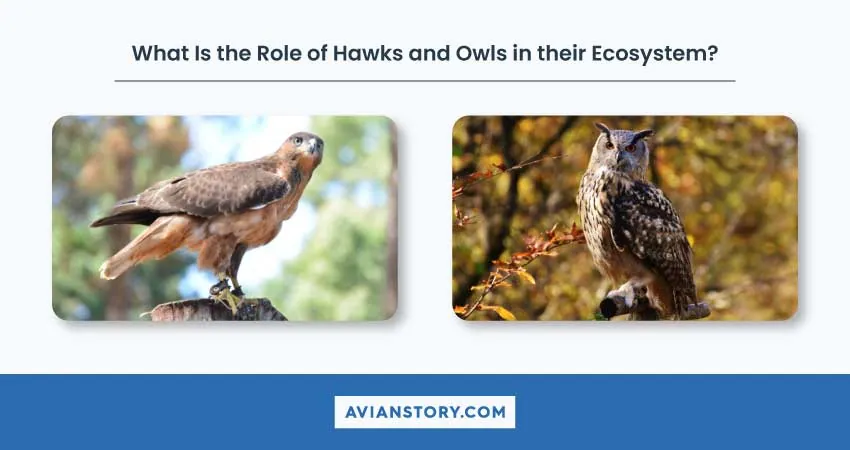
Hawks and Owls play very crucial roles in maintaining the balance of the ecosystem they live in as both predators and prey.
As Predators
You may see that hawks and Owls hunt many small to medium-sized animals. Usually, they hunt small mammals like mice and voles and reptiles like snakes, lizards, etc. However, sometimes the bigger ones hunt the smaller raptors, too.
This action helps to maintain the multiplication of the small mammals and other prey of these birds. So the ecosystem does not fall apart.
What Animals Eat Hawks and Owls?
These birds also become prey for bigger members of the bird of prey family, like bigger hawks, owls, and eagles, and mammals like raccoons, Foxes, etc. These ensure the birds will not increase in number without limit and will not break the balance of the ecosystem.
How are Hawks and Owls Represented in Culture and Symbolism?

Both hawks and owls symbolize different omens and roles in many different societies and cultures.
Hawks in Different Cultures
Some societies, including Native Americans, consider hawks to be influential leaders of spirituality and persistence. Also, in some tribes, like the Algonquin tribe, hawks represent wisdom. They are also regarded as spiritual messengers and bravery symbols in the Celtic Tribe.
Owls in Different Societies
Owls symbolize knowledge and luck in many cultures and societies, including Japan and Korea. However, in certain cultures, like India, owls are considered wizardry and a bad omen symbol.
What Threats Do Hawks and Owls Face in Today’s World?
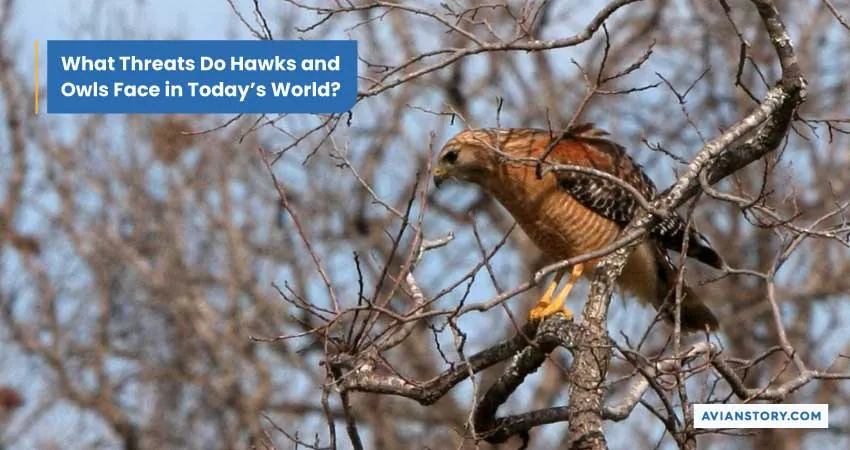
Though most of the species of these two birds are not endangered, their overall population is declining. Among the endangered species, Ridway’s Hawk and Congo Bay Owl are considered the most vulnerable. Let’s take a look at the factors behind these threats.
Environmental Challenges
The destruction of habitats of both species is the most challenging environmental fact. We are destroying the forest to accommodate the increased population. Thus, their usual nesting is decreasing continuously. So, many of the species are facing extinction threats.
Human Activity
We are the real culprits for the decreasing number of hawks and owls. Humans are invading their habitat, poisoning the water, and hunting them. We also build our own houses near their nests. This activity certainly disturbs their natural hunting, as their prey will run away because of the new buildings.
Changing Climate
Humans are also behind rapid climate change and global warming. Global warming is known to be responsible for excessive heat and ice melting. Snowy Owls and Burrowing Owls are two examples of birds that are currently at risk of going extinct because they reside in snowy climates.
Additionally, it made the Red Tail Hawks live in an endangered environment and pushed them to stop migrating before winter.
What Conservation Measures Are in Place for Hawks and Owls?
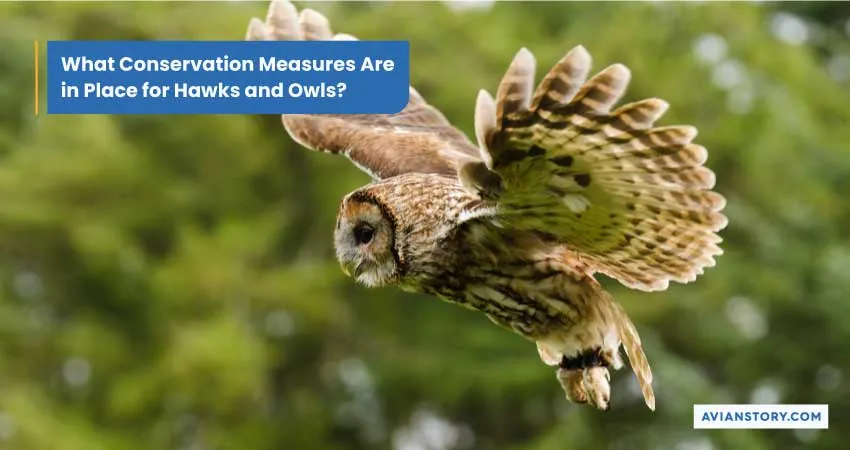
To safeguard these two birds, especially the endangered species, both conversational activities and rehabilitation centers are important. Let’s look into the overall measurements taken by them.
Conversational Measures
Many governments and non-profit organizations, like The Nature Conservancy, Owl Research Institute, Hawks Aloft, Inc., etc., have come forward to save them.
They usually mark the habitat of endangered species and restrict unauthorized movement. They are trying to create a proper environment for the bird’s habitat. Also, they allow the birds to hunt by making their habitat abundant with prey. However, they do not feed them directly.
Role of Rehabilitation Centers
Also, there are many rehabilitation centers for injured, old, and orphaned hawks and owls. Usually, they will train the orphaned bird and raise it for a while.
After the baby birds become mature and the injured make a full recovery, the rehabilitation center will release them to the wildlife.
Final Word
Now, you have a clear idea about hawks vs. owls. Both are predatory birds with great vision and excellent hunting strategies. However, when comparing their powers, owls might have slightly more advantages than same-size hawks.
Also, as some of their species are declining in number, you should never hunt them or disturb the owl and hawk nesting areas. Instead, help save them by donating to conservation institutes or rescuing endangered species. Moreover, the information related to these birds is updated regularly. So follow us to learn more.
